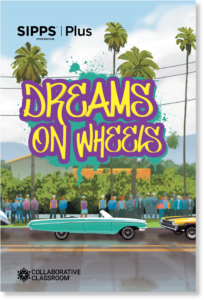 When students have reached high school and still have significant phonics gaps, how can we help these striving older readers finally experience success?
When students have reached high school and still have significant phonics gaps, how can we help these striving older readers finally experience success?
Dr. Jennifer McMahon, a veteran district administrator and literacy specialist, shares five critical elements for supporting striving older readers, based on her own district’s work to provide reading intervention for their most at-risk students in high school.
I sidled up next to a high school student and casually asked my trademark question, “What are you reading and loving?”
He barely glanced up from the paper he was doodling on and said, “Oh. I don’t read.”
I was sure I must have misheard him or maybe misunderstood him. I tried again and smiled, “Well, maybe you haven’t found the right book. What do you like to read about?”
This seemed to catch his attention. He actually glanced up when he replied, “I don’t have to read. It’s on my IEP.”
After I researched this a bit, I discovered that his statement was pretty accurate. This high school student had so many accommodations and modifications that he effectively did not have to read during his school day. Furthermore, I could find no plan for how he might actually close his phonics gaps.
This high school student had so many accommodations and modifications that he effectively did not have to read during his school day. Furthermore, I could find no plan for how he might actually close his phonics gaps.
As I looked into this more, I realized this high school student was not alone! Clearly, our district needed a plan to help these striving older readers address the gaps in their foundational skills.
As we developed a plan, the SIPPS program played an important role. Specifically, we began implementing SIPPS as an intervention for our most at-risk students in high school.
Through this implementation, we have seen growth. Oh, and I do mean growth! Students who had given up on ever learning to read are passing mastery test after mastery test, and their decoding and encoding skills are evident in their reading and writing.
Along the way, we identified some elements that are critical for the growth of older striving readers in high school. Here they are!
Element #1: Routines and Systematic Instruction Ensure that Older Readers Experience Success
If a student has reached high school and still has significant phonics gaps, the first priority is to ensure this student experiences success.
The SIPPS routines are predictable and are designed to lead students to success. Because they are modeled and guided, and because students respond chorally in SIPPS lessons, students’ fear of failure is mitigated.
This is so incredibly important because students who reach high school with phonics gaps are often convinced they can’t learn or grow as a reader.
Students who reach high school with phonics gaps are often convinced they can’t learn or grow as a reader.
Don’t be tempted to modify the SIPPS routines or add “pizzazz.” When I first started teaching the program, it was difficult for me to just stick to the routine, but I soon realized that the predictable nature of the routine and the minimal teacher talk are critical for student growth.
What a teacher may see as “too repetitive” is exactly what allows older readers to let down their guard and trust the process. The students know exactly what to expect; this allows them to focus only on the new learning.
What a teacher may see as “too repetitive” is exactly what allows older readers to begin to let down their guard and trust the process. The students know exactly what to expect; this allows them to focus only on the new learning.
Element #2: Immediate Feedback Builds Confidence for Older Readers
Frequent mastery tests in SIPPS allow for immediate feedback for students after only a few lessons. This allows them to see their own growth. For many students, seeing how much they learned in a short period of time provides a much-needed confidence boost. I cannot emphasize this enough!
Because of the structure of SIPPS lessons, as long as routines are consistent and corrective feedback is provided, students will likely show mastery on these assessments. One of my high school student told me it was the first time in his life he had gotten a perfect score on a test.
These mastery tests become the evidence that reassures our most vulnerable students that they are readers.
These mastery tests become the evidence that reassures our most vulnerable students that they are readers.
When they say, “I can’t do it,” then we can point to these mastery tests and say, “But, look! You already ARE doing it.” It is hard to argue with data.
Element #3: For Older Students, Create a Schedule that Honors This Work
High school students have to be concerned with credits, so carving out an intervention time is not easy.
Students with disabilities often need time during the day to complete work for other classes. So, even if they have resource room, they are often reluctant to use this time for “that phonics stuff.” (This is an actual quote.)
Our high school principal created a credit-bearing class for students receiving SIPPS.
Our high school principal created a credit-bearing class for students receiving SIPPS. This allowed students to have a class in their schedule where their needs were being met AND also moved them closer to graduation.
The class includes the SIPPS lesson and independent reading time, so students can apply their learning, and teachers can confer with students.
Element #4: Provide Texts that Honor the Dignity of Older Readers

Dreams on Wheels, part of SIPPS Plus
We also learned the importance of honoring students’ dignity. The Dreams on Wheels book used in SIPPS Plus looks like a real chapter book, so students were not embarrassed to carry it around with them.
As students moved through SIPPS Plus and toward SIPPS Challenge, we made sure to invest in high-interest, lower-reading-level books to continue to support their reading growth.
We also pointed students toward e-books. Several students expressed how reading e-books helped them feel more comfortable: nobody could see the book cover and make judgments.
Element #5: Foster Agency Through Choice
Probably the biggest difference between using SIPPS with elementary students and using it with high school students is the even greater need to be flexible and ready to respond to the suggestions of high school students.
If a student is in high school and has phonics gaps, then they very likely also have a negative self-concept. Experiencing success is one way to help students rebuild their confidence, but older students also need to develop agency—the idea that they can make choices and have control over their lives.
Older students also need to develop agency—the idea that they can make choices and have control over their lives.
We saw over and over (usually at the point where students were almost ready to test out completely) that as they gained confidence, they also offered suggestions to modify the lessons.
This requires sophisticated decision-making. The person providing the intervention has to be absolutely clear about the purpose of the lesson or the particular part the student wants to change. Sometimes it is easy: “Can we use green markers instead of blue?” And sometimes it requires more thought.
Regardless, showing respect for students’ ideas and accommodating them when possible is so important. When students begin to volunteer ideas and suggestions, it is a sign that they are developing greater ownership of their own learning.
As they stand on the edge of adulthood, this sense of control over their own development is exactly what these students need to continue to grow beyond high school.
Conclusion: We Can Help Striving Readers in High School Succeed
I am writing these thoughts after having a nice chat with a rising Sophomore at the high school. He is coming in every day this summer for SIPPS and independent reading because he wants to have room in his schedule for an elective next year.
I watched him decode every word that was put in front of him. Then he read aloud to me too. He is on target to complete the Challenge Level in SIPPS in just a few weeks.
Oh, and did I mention? This is the student who only a year ago said, “I don’t read.” Excuse me as I blink back these tears.
***
Related Reading
Also by Dr. Jennifer McMahon: Fostering Book Love in Older Readers
Spotting Reading Difficulties: Early Indicators for Middle and High School Educators
How Harlingen CISD Uses SIPPS with Striving Readers in Grades 6–12
Serving Striving Middle School Readers in the Bronx: An Interview with ENL Teacher Desiree Torres
About Dr. Jennifer McMahon

Dr. Jennifer McMahon
Dr. Jennifer McMahon is an independent education consultant and professional learning lead partnering with Collaborative Classroom. Dr. McMahon is an experienced school district administrator, professional development specialist, and literacy specialist. She received her Ed.D. in K–12 school leadership from the University of Rochester. She also achieved National Board Certification in early and middle childhood literacy.
Dr. McMahon’s passion is helping educators develop their expertise in order to meet the needs of all learners. Her wide-ranging research interests include: developing teacher agency and facilitating the empowerment of educators in limited resource communities; restoring hope for older readers; and the development of new literacies. She has experience teaching and leading implementations that include SIPPSⓇ, Being a Reader™, Being a Writer™, and Caring School Community®.
